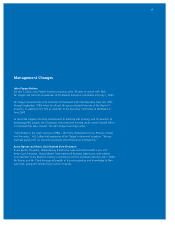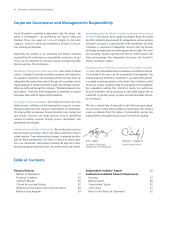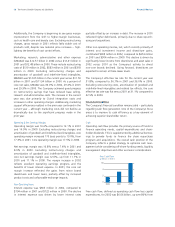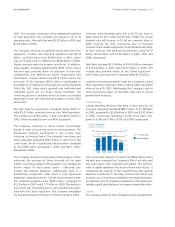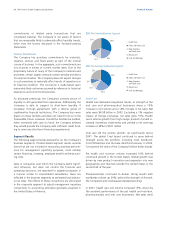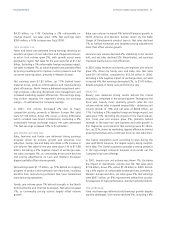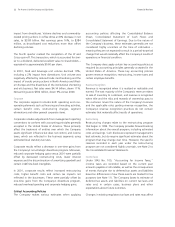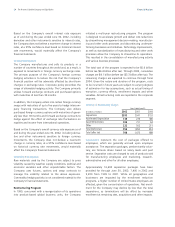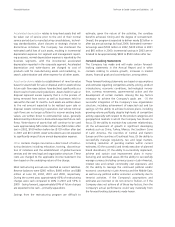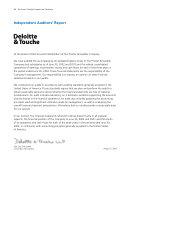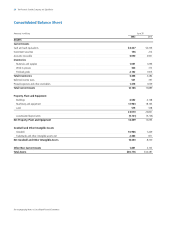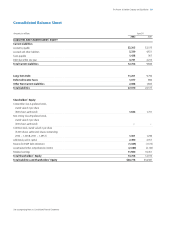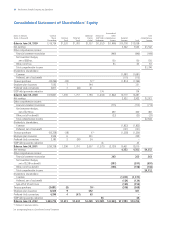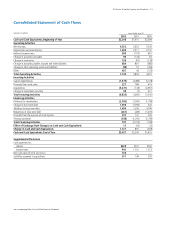Proctor and Gamble 2002 Annual Report Download - page 25
Download and view the complete annual report
Please find page 25 of the 2002 Proctor and Gamble annual report below. You can navigate through the pages in the report by either clicking on the pages listed below, or by using the keyword search tool below to find specific information within the annual report.the Company’s ability to successfully manage regulatory
matters around the world, and future business results may
affect the amount of deferred tax liabilities or the valuation
of deferred tax assets over time. The Company’s accounting
for deferred tax consequences represents management’s best
estimate of future events that can be appropriately reflected
in the accounting estimates. Although certain changes
cannot be reasonably assumed in the Company’s current
estimates, management does not believe such changes
would result in a material period-to-period impact on the
results of operations or financial condition.
Employee Benefits
Employee benefits include pensions – both defined contribu-
tion and defined benefit – and other post-employment
benefits (OPEB), with plans and benefits established locally.
At the Corporate level, there is an employee stock ownership
plan (ESOP) and a stock option plan.
Under the provisions of SFAS No. 87, “Employer’s Account-
ing for Pensions” and SFAS No. 106, “Employer’s Accounting
for Postretirement Benefits Other Than Pensions,” measure-
ment of the obligations under the defined benefit pension
plans and OPEB plans are subject to a number of assump-
tions. These include the rate of return on plan assets, health
care cost trend rates and the rate at which the future
obligations are discounted to the value of the liability at June
30th of each year presented in the Consolidated Balance
Sheet (see Note 10).
Certain defined contribution pension and OPEB benefits in the
United States are funded by the ESOP plan (see Note 9). The
ESOP plan is accounted for under the provisions of AICPA
Statement of Position No. 76-3, “Accounting Practices for
Certain Employee Stock Ownership Plans.” Series A shares are
used to fund a portion of the defined contribution plan and
Series B shares are used to fund a portion of retiree health
care benefits – a component of OPEB. Changes in estimates
and assumptions that are implicit in accounting for the ESOP
would not have a material impact on the results of operations.
Under SFAS No. 123, ”Accounting for Stock-Based Compen-
sation,” the Company has elected to account for stock
options under APB Opinion No. 25, ”Accounting for Stock Is-
sued to Employees,” based on their intrinsic value at the date
of grant. Because options generally are granted at market val-
ue, there is no intrinsic value and resultant compensation ex-
pense. Note 8 provides supplemental information, including
pro forma earnings and earnings per share, as if the Company
had accounted for options based on the method prescribed by
SFAS No. 123. That methodology yields an estimate of fair
value based on a measurement method that contains a num-
ber of management estimates, including estimated option life
and future volatility. Changes in these assumptions could
significantly impact the estimated fair value of the options.
Hedging and Derivative Financial Instruments
As a multinational company with diverse product offerings,
the Company is exposed to market risks, such as changes in
interest rates, currency exchange rates and commodity
prices. To manage the volatility relating to these exposures,
the Company evaluates its exposures on a global basis to
take advantage of the netting opportunities that exist. For
the remaining exposures, the Company enters into various
derivative transactions in accordance with the Company’s
hedging policies. The financial impacts of these hedging
instruments are offset in part or in whole by corresponding
changes in the underlying exposures being hedged. The
Company does not hold or issue derivative financial
instruments for speculative trading purposes. Note 7 includes
a more detailed discussion of the Company’s accounting
policies for financial instruments.
Derivative positions are monitored using techniques
including market valuation, sensitivity analysis and value at
risk modeling. The tests for interest rate and currency rate
exposures discussed below are based on a Monte Carlo
simulation value at risk model using a one year horizon and a
95% confidence level. The model incorporates the impact of
correlation and diversification from holding multiple currency
and interest rate instruments and assumes that financial
returns are normally distributed. Estimates of volatility and
correlations of market factors are drawn from the Risk-
Metrics™ dataset as of June 28, 2002. In cases where data is
unavailable in RiskMetrics™
, a reasonable proxy is included.
The Company’s market risk exposures relative to interest and
currency rates, as discussed below, have not changed mate-
rially versus the previous reporting period. In addition, the
Company is not aware of any facts or circumstances that
would significantly impact such exposures in the near term.
Interest Rate Exposure
Interest rate swaps are used to hedge underlying debt
obligations. Certain currency interest rate swaps are desig-
nated as hedges of the Company’s foreign net investments.
Financial Review 23The Procter & Gamble Company and Subsidiaries




